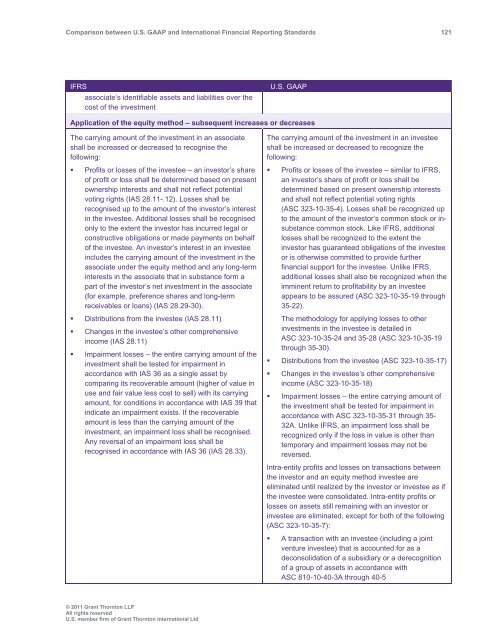Comparison between U.S. GAAP and International ... - Grant Thornton
Comparison between U.S. GAAP and International ... - Grant Thornton
Comparison between U.S. GAAP and International ... - Grant Thornton
Create successful ePaper yourself
Turn your PDF publications into a flip-book with our unique Google optimized e-Paper software.
<strong>Comparison</strong> <strong>between</strong> U.S. <strong>GAAP</strong> <strong>and</strong> <strong>International</strong> Financial Reporting St<strong>and</strong>ards 121<br />
IFRS<br />
associate’s identifiable assets <strong>and</strong> liabilities over the<br />
cost of the investment<br />
U.S. <strong>GAAP</strong><br />
Application of the equity method – subsequent increases or decreases<br />
The carrying amount of the investment in an associate<br />
shall be increased or decreased to recognise the<br />
following:<br />
• Profits or losses of the investee – an investor’s share<br />
of profit or loss shall be determined based on present<br />
ownership interests <strong>and</strong> shall not reflect potential<br />
voting rights (IAS 28.11-.12). Losses shall be<br />
recognised up to the amount of the investor’s interest<br />
in the investee. Additional losses shall be recognised<br />
only to the extent the investor has incurred legal or<br />
constructive obligations or made payments on behalf<br />
of the investee. An investor’s interest in an investee<br />
includes the carrying amount of the investment in the<br />
associate under the equity method <strong>and</strong> any long-term<br />
interests in the associate that in substance form a<br />
part of the investor’s net investment in the associate<br />
(for example, preference shares <strong>and</strong> long-term<br />
receivables or loans) (IAS 28.29-30).<br />
• Distributions from the investee (IAS 28.11)<br />
• Changes in the investee’s other comprehensive<br />
income (IAS 28.11)<br />
• Impairment losses – the entire carrying amount of the<br />
investment shall be tested for impairment in<br />
accordance with IAS 36 as a single asset by<br />
comparing its recoverable amount (higher of value in<br />
use <strong>and</strong> fair value less cost to sell) with its carrying<br />
amount, for conditions in accordance with IAS 39 that<br />
indicate an impairment exists. If the recoverable<br />
amount is less than the carrying amount of the<br />
investment, an impairment loss shall be recognised.<br />
Any reversal of an impairment loss shall be<br />
recognised in accordance with IAS 36 (IAS 28.33).<br />
The carrying amount of the investment in an investee<br />
shall be increased or decreased to recognize the<br />
following:<br />
• Profits or losses of the investee – similar to IFRS,<br />
an investor’s share of profit or loss shall be<br />
determined based on present ownership interests<br />
<strong>and</strong> shall not reflect potential voting rights<br />
(ASC 323-10-35-4). Losses shall be recognized up<br />
to the amount of the investor’s common stock or insubstance<br />
common stock. Like IFRS, additional<br />
losses shall be recognized to the extent the<br />
investor has guaranteed obligations of the investee<br />
or is otherwise committed to provide further<br />
financial support for the investee. Unlike IFRS,<br />
additional losses shall also be recognized when the<br />
imminent return to profitability by an investee<br />
appears to be assured (ASC 323-10-35-19 through<br />
35-22).<br />
The methodology for applying losses to other<br />
investments in the investee is detailed in<br />
ASC 323-10-35-24 <strong>and</strong> 35-28 (ASC 323-10-35-19<br />
through 35-30).<br />
• Distributions from the investee (ASC 323-10-35-17)<br />
• Changes in the investee’s other comprehensive<br />
income (ASC 323-10-35-18)<br />
• Impairment losses – the entire carrying amount of<br />
the investment shall be tested for impairment in<br />
accordance with ASC 323-10-35-31 through 35-<br />
32A. Unlike IFRS, an impairment loss shall be<br />
recognized only if the loss in value is other than<br />
temporary <strong>and</strong> impairment losses may not be<br />
reversed.<br />
Intra-entity profits <strong>and</strong> losses on transactions <strong>between</strong><br />
the investor <strong>and</strong> an equity method investee are<br />
eliminated until realized by the investor or investee as if<br />
the investee were consolidated. Intra-entity profits or<br />
losses on assets still remaining with an investor or<br />
investee are eliminated, except for both of the following<br />
(ASC 323-10-35-7):<br />
• A transaction with an investee (including a joint<br />
venture investee) that is accounted for as a<br />
deconsolidation of a subsidiary or a derecognition<br />
of a group of assets in accordance with<br />
ASC 810-10-40-3A through 40-5<br />
© 2011 <strong>Grant</strong> <strong>Thornton</strong> LLP<br />
All rights reserved<br />
U.S. member firm of <strong>Grant</strong> <strong>Thornton</strong> <strong>International</strong> Ltd
















